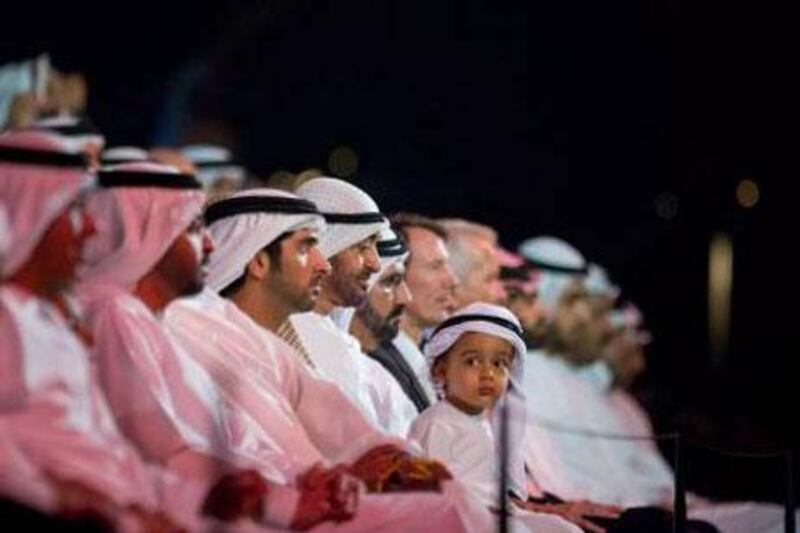ABU DHABI // Celebrations for Qasr Al Hosn's 250-year anniversary began yesterday with a cavalry procession to the fort in downtown Abu Dhabi, symbolising the Royal Family's journey from Liwa to the island.
The ceremony was attended by Sheikh Mohammed bin Rashid, Vice President and Ruler of Dubai, and Sheikh Mohammed bin Zayed, Crown Prince of Abu Dhabi and Deputy Supreme Commander of the Armed Forces, who took part in traditional dances to the crowd’s delight.
Sheikh Mohammed bin Zayed compared the UAE to Qasr Al Hosn, saying the country was “a unified and strong fort”, the state news agency Wam reported. A few hours later the gates of Qasr Al Hosn were crowded with curious residents, eager to catch a first close look at the historic white fort.
“It’s my first time inside. I don’t know what it is like but I’ll see,” said Khaled Ismail, a Bangladeshi cook who had lived beside the fort for eight years.
Images of the island’s history were projected on to the great white walls of the fort, which provided the backdrop for an open-air theatre.
There visitors watched traditional dancing as Abu Dhabi Police watched on in traditional uniforms to commemorate the founding of the force in 1957.
For Mr Ismail, who speaks in quick pidgin Arabic and wears a pristine Emirati kandura on special occasions, it was a rare chance to learn about UAE history.
He had come with his friends Jamal Meya, 25, a driver, and Mortaz Ali, 20, a carpenter who has lived here for six years.
The festival is divided into four sections: a marine area, where visitors can board a replica pearling ship and see pearls extracted from oyster shells; the Abu Dhabi island area where old mariners sing sea shanties; a desert area with traditional souq of palm-frond stalls, selling Emirati favourites such as chabaab pancakes; and the oasis area.
“This fort, it’s everything, everything,” said Muna Al Suwaidi, 34, a festival volunteer. She coyly admitted the fort was not as large as she imagined in childhood. “I don’t want it to disappear. I want it to be here.”
The audience filmed and clicked the performance on their mobile phones, competing for bragging rights of being the first to upload images of the festival.
“The fort gives me that touch in my heart,” said Fatima Al Fathi, 15, an Emirati raised in Abu Dhabi. “I don’t know how to express it. It’s ineffable.”
Fatima had brought her brother Hamdan, 4, and her cousin Noora, 10, to teach them the history her parents had taught her.
“It’s actually really cool because I figured out something I never knew, like the people with the guns,” said Fatima.
Elderly Emiratis from across the country volunteered as storytellers and singers, while others displayed their skills with handicrafts, from boat building to rope making.
“This fort, it’s our history. We also have our old forts,” said Rashed Saeed, from the east-coast Sharjah enclave of Dibba Al Hisn.
Mr Saeed is famous for his ability to twist palm fibre into rope. A friend insisted that he volunteer for the event when he saw it advertised on television.
Although Mr Saeed is from a town separated from Abu Dhabi by a four-hour journey over desert, sea and mountains, he considers the fort’s history his own.
“Abu Dhabi is my country,” he said. “We are all from one place. Dibba, Abu Dhabi, it’s one nation. Dubai, Ras Al Khaimah, we are all brothers.
“If I said I would not come and another man said he would not come, then who would be here?”
The festival runs until March 9.






